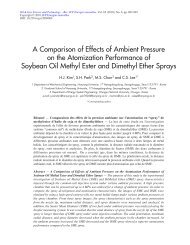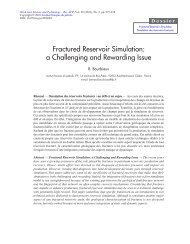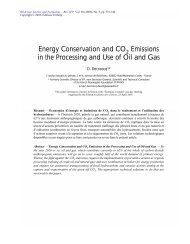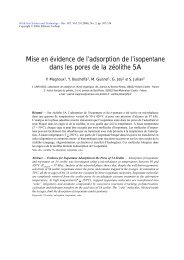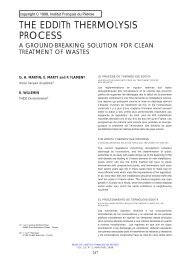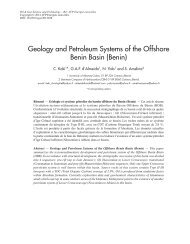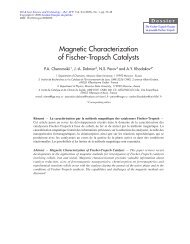PDF (509.1 KB) - Oil & Gas Science and Technology - IFP Energies ...
PDF (509.1 KB) - Oil & Gas Science and Technology - IFP Energies ...
PDF (509.1 KB) - Oil & Gas Science and Technology - IFP Energies ...
Create successful ePaper yourself
Turn your PDF publications into a flip-book with our unique Google optimized e-Paper software.
<strong>Oil</strong> & <strong>Gas</strong> <strong>Science</strong> <strong>and</strong> <strong>Technology</strong> – Rev. <strong>IFP</strong> <strong>Energies</strong> nouvelles, Vol. 66 (2011), No. 6, pp. 1025-1033Copyright © 2011, <strong>IFP</strong> <strong>Energies</strong> nouvellesDOI: 10.2516/ogst/2011101A New Multi-Sample EOS Model for the <strong>Gas</strong>Condensate Phase Behavior AnalysisA. Mehrabian 1, 2* <strong>and</strong> F. Crespo 31 Center of Excellence in Energy Conversion, Mechanical Engineering Department, Sharif University of <strong>Technology</strong>, Tehran - Iran2 Department of Chemical <strong>and</strong> Petroleum Engineering, Sharif University of <strong>Technology</strong>, Tehran - Iran3 Mewbourne School of Petroleum <strong>and</strong> Geological Engineering, University of Oklahoma, Norman, Oklahoma - USAe-mail: amin@ou.edu - freddy.crespo@ou.edu* Corresponding authorRésumé — Un nouveau modèle d’EOS multi-échantillon pour l’analyse de comportement de phasede condensat de gaz — Les équations d’état (EOS) sont largement utilisées pour prédire lecomportement des phases des fluides de réservoir. Par rapport aux modèles classiques de corrélation, laprécision des techniques de modélisation par EOS a permis une amélioration des prédictions despropriétés de ces fluides. Lorsque le pétrole brut ou les condensats de gaz ont été correctementcaractérisés au moyen d’un nombre limité de tests de laboratoire, leur comportement PVT peut êtrefacilement étudié dans différentes conditions. Dans cet article, le comportement PVT du condensat degaz d’un réservoir dans le champ de gaz de South Pars en Iran a été modélisé en suivant les équationsd’état à trois paramètres de Patel et Teja. La méthode de caractérisation multi-échantillons est utiliséepour obtenir un modèle cohérent pour le gaz rétrograde dans le réservoir entier. Les échantillons de fluidesont d’abord analysés dans un but de cohérence afin de découvrir d’éventuelles anomalies dans lespropriétés du réservoir/fluide. Par la suite, les données cohérentes relatives aux fluides sont utilisées pourobtenir des paramètres pour le modèle EOS. Une procédure simplifiée d’agrégats avec une fraction àpseudo-composante, obtenue au moyen de la méthode de fractionnement de Pederson, est utilisée pourles échantillons afin de caractériser de façon unique le composant lourd de fluide du réservoir. Lesrésultats des tests de constante de composition et de diminution constante de volume ainsi que lespressions expérimentales de pointe de rosée sont utilisés pour le réglage des EOS. Les résultats ontdémontré que l’utilisation du modèle EOS permet de très bonnes similitudes entre les propriétés PVTprédites avec les données obtenues expérimentalement. Ces résultats confirment l’utilité des réglages àl’aide d’EOS sur les propriétés des fractions lourdes quel que soit l’échantillon. Le modèle EOSdéveloppé pour ce site particulier peut être utilisé dans des études de simulation concernant les projets derécupération.Abstract — A New Multi-Sample EOS Model for the <strong>Gas</strong> Condensate Phase Behavior Analysis —Equations of State EOS are vastly being used to predict the phase behavior of reservoir fluids. Theaccuracy of EOS modeling technique over conventional correlation models would benefit an improvedproperty prediction of these fluids. Once the crude oil or gas condensate fluid system has been probablycharacterized using limited laboratory tests, its PVT behavior under a variety of conditions can be easilystudied. In this paper, the PVT behavior of gas condensate from a reservoir in South Pars retrograde gasfield in Iran was modeled using the three-parameter Patel <strong>and</strong> Teja Equation of State. The multi-samplecharacterization method is used to arrive at one consistent model for retrograde gas in the wholereservoir. The fluid samples are first analyzed for consistency. To ensure that there is not any abnormalchanges in fluid/reservoir properties, <strong>and</strong> then the consistent fluid data are used to obtain parameters for
1026<strong>Oil</strong> & <strong>Gas</strong> <strong>Science</strong> <strong>and</strong> <strong>Technology</strong> – Rev. <strong>IFP</strong> <strong>Energies</strong> nouvelles, Vol. 66 (2011), No. 6EOS model. A simplified lumping procedure along with a consistent C 12+ pseudo-component split usingthe Pederson splitting method is used for the samples in order to uniquely characterize the heavy fractioncomponent of the reservoir fluid. The results of constant composition expansion <strong>and</strong> constant volumedepletion laboratory tests as well as the experimental dew point pressures are used for EOS tuning. Theresults demonstrated a very good match of PVT properties predicted using the EOS model withexperiment <strong>and</strong> laboratory tests for this field. These results confirm the usefulness of the EOS tuning onheavy fraction properties for all samples. The EOS model developed for this particular field may be usedin simulation studies concerning recovery projects.NOMENCLATUREAPD Average Perforation DepthMW Molecular WeightP PressureP d Dew point pressureP r Reservoir pressureT TemperatureV VolumeZ Compressibility factork ij Binary interaction coefficientn Carbon numberw Average weight fractionz Mole fractionGreek symbolsΔ Tuning objective functionϕ Fugacityα, β Parameters defining Pederson splitting formulaγ Specific gravityλ Weighting factorξ Parameter in PT-EOSSubscriptsc Critical propertyd Dew pointi, j Componentm Mean property of the mixtureSuperscriptsexppredExperimental valueEOS predicted valueINTRODUCTIONIn successful design of recovery processes for discoveredreservoirs, proper knowledge about the phase behavior <strong>and</strong>other thermodynamic properties of the reservoir fluids wouldbe of great importance. In this regards, considerable efforthave been devoted to develop accurate models for the predictionof phase behavior <strong>and</strong> thermodynamic properties ofpetroleum fluids, which usually contain a variety of hydrocarbons<strong>and</strong> other organic <strong>and</strong> inorganic compounds.Equations of state have been traditionally used in volumetric<strong>and</strong> phase behavior modeling of reservoir fluids. These modelshave the advantage over PVT correlations that they wouldbe valid for a wide variety of fluids from different reservoirs.Redlich <strong>and</strong> Kwong (1949) showed that a simple modificationin the attractive term of the Van der Waals EOS wouldresult in a significant improvement in the volumetric phasebehavior of the vapors. They deduced their equation on thebasis of the observation that if the system pressure growsinfinitely, the molar volume of a substance would be reducedto 0.26 of the critical volume. A great improvement suggestedby Soave (1972) was substitution of the attractiveterm of the RK-EOS with a more general parameter thatdepends on the reduced temperature <strong>and</strong> acentric factor of thesubstance. Later, Graboski <strong>and</strong> Daubert (1978) <strong>and</strong> Sim <strong>and</strong>Daubert (1980) suggested better correlations for dependencyof the attractive parameter to acentric factor to improve thepredictions of the vapor pressures of pure substances. TheEquation of state introduced by Peng <strong>and</strong> Robinson (1976)has become one of the most widely used models for petroleumfluid properties prediction. They demonstrated that theperformance of SRK-EOS in predicting the liquid phase specificgravity would be augmented by introducing an experimentalparameter obtained by the analysis of the criticalcompressibility factor.Numerous studies have attempted to improve the capabilitiesof EOSs. The chief progress in development of EOS modelingwas the introduction of three parameter EOSs. The thirdparameter provides a better flexibility for prediction ofcritical compressibility factor <strong>and</strong> volumetric behavior ofliquid phases (Danesh, 1998). Heyen (1983) introduced amodified PR-EOS in which a third parameter was included toachieve the real critical compressibility factor for various fluids.Kubic (1982) used a modified three parameter MartinEquation for calculation of vapor-liquid equilibrium. Moreelaborate equations of state were introduced later by otherresearchers. Shmidt <strong>and</strong> Wenzel (1980) utilized the acentricfactor as the third parameter in their EOS while, Patel <strong>and</strong>Teja (1982) introduced a three parameter EOS with critical
A Mehrabian <strong>and</strong> F Crespo / A New Multi-Sample EOS Model for the <strong>Gas</strong> Condensate Phase Behavior Analysis 1027compressibility factor as the independent variable which maybe obtained from the experiment. They suggested that agreater value for this parameter should be applied in the EOSin order to obtain reasonable results for prediction of specificgravities at extreme pressures.The method of volume shift was first introduced byPeneloux et al. (1982) <strong>and</strong> Jhaveri <strong>and</strong> Youngren (1984) toimprove the accuracy of SRK-EOS <strong>and</strong> PR-EOS. They alsoprovided a correlation to define the volume shift for theheavy hydrocarbon components. Much improvement resultedfrom the introduction of parameters called Binary InteractionCoefficients, BICs, to better match the saturation pressurepredictions. Slot-Petersen (1987) found the major characteristicsfor BICs. He provided the basis of a theory whichdescribes the methods for calculating BICs. Groboski <strong>and</strong>Daubert (1978) urged that the use of BICs is not necessary inEOS modeling of hydrocarbon systems. However, Katz <strong>and</strong>Firooz-abadi (1978) proposed a fixed set of BICs formethane–hydrocarbon mixtures. Coats <strong>and</strong> Smart (1986)introduced the EOS tuning technique to enhance the performanceof equations of state in predicting the experimentalPVT data. They found that the critical properties of the heavycomponents, the parameter Ω for methane <strong>and</strong> BICs can beadjusted or “tuned” with available experimental data toobtain reasonable predictions. Pedersen et al. (1989) alsofound that the properties of heavy components may be usedas the regression parameters during the EOS tuning process.Merril <strong>and</strong> Newly (1993) reported a systematic investigationinto the most suitable data for the development of equationsof state for petroleum reservoir fluids. Merril et al. (1994)presented a comparison between different EOS tuning techniques.Abrishami et al. (1997) suggested a tuning method ofPeng-Robinson equation of state for simulation of compositionalchange in flue gas injection processes. The tuninginvolved the critical properties <strong>and</strong> acentric factor of heavycomponents, the Ω values of the equation of state, as wellas the Binary Interaction Coefficients. They concluded intheir work that completely different tunings were neededfor a simple volumetric match or for the more complicatedcomposition match.Components with a carbon number higher than 6 are oftengrouped as a single component called heptanes-plus fractionor C 7+ specially, in the absence of detailed analytical data.One can also group components with a higher carbon number.For the past two decades, proper characterization ofheavy fractions encountered in nearly all reservoir fluids hasbeen the major problem in PVT modeling. Adequate characterizationof the heavy fractions is critical due to its profoundeffect on the PVT properties <strong>and</strong> the phase equilibria of ahydrocarbon system. Especially, volumetric <strong>and</strong> phasebehavior of the gas condensate.The splitting technique is one of the most widely acceptedmethods for reducing errors with C 7+ characterization. Thistechnique consists on breaking the C 7+ into a finite number offractions called pseudo components. Katz (1983) developed asimple graphical method for C 7+ splitting. His method wasbased on the extended analysis on the behavior of differentcondensate systems. Pedersen et al. (1982) offered an exponentialrelationship between mole fraction <strong>and</strong> Carbon numberof the split fractions. However, Whitson et al. (1988)used a more elaborate gamma distribution function todescribe such relationship. Ahmed et al. (1985) used the molecularweight <strong>and</strong> the mole fraction of the heavier fractionsas the input parameters for their split method. A simple recursiverelationship for obtaining the molecular weight of eachpseudo-component was used in their model. Riazi (1997)suggested a two parameter distribution model. His resultswere in excellent agreement with the laboratory data.Often, a large number of pseudo-components is sufficientto obtain satisfactory predictions of the PVT behavior.However, the maximum number of components that can beused in compositional models are limited due to cost <strong>and</strong>computing time. Therefore, the original components have tobe grouped or lumped into a smaller number of pseudo-components.Several methods to use this technique without losingthe predicting power of the equation of state have been presented(Lee et al., 1979; Whitson, 1980; Hong, 1982).In this paper, the PVT behavior of gas condensate systemproduced from different production wells in South Pars gasfield located in Iran is modeled based on the Patel <strong>and</strong> TejaEquation of state. A multi-well characterization method isutilized along with an extensive validation with the accuratelaboratory data. A simplified lumping procedure along with aconsistent C 12+ pseudo-component split using the Pedersonsplitting method is used for the samples in order to uniquelycharacterize the heavy fraction component of the reservoirfluid. The Constant Volume Depletion (CVD) <strong>and</strong> ConstantComposition Expansion (CCE) tests are simulated with thetuned equation of state. To examine the capability of suggestedEOS model <strong>and</strong> regression scheme in PVT analysis ofgas condensate systems, simulated separator test results arecompared with some simulation results based on conventionalEOS modeling methods.1 THE THREE-PARAMETER PT-EOSThe Patel <strong>and</strong> Teja equation of state, PT-EOS (1982), is usedin this study to model the PVT behavior of several gascondensate samples. Their equation may be written as follows:RT aP =V − b− 2V − b+c V bcwhere, the following conditions must hold for Equation (1):∂P= 0∂V Tc( ) −(1)(2)
1028<strong>Oil</strong> & <strong>Gas</strong> <strong>Science</strong> <strong>and</strong> <strong>Technology</strong> – Rev. <strong>IFP</strong> <strong>Energies</strong> nouvelles, Vol. 66 (2011), No. 6Patel <strong>and</strong> Teja urged that the third parameter c in theequation will result in the arbitrary selection of the experimentalparameter ξ c . Applying (2), (3) <strong>and</strong> (4) in (1) yieldsthe following equations for the parameters of the EOS:where:2 2RTca = Ω ⎡a+ m −TP⎣1 1(3)(4)(5)(6)(7)Ω c = 1 – 3ξ c (8)Ω a = 3ξ c 2 + 3(1 – 2ξ c ) + Ω b 2 + (1 – 3ξ c ) (9)<strong>and</strong>, Ω b is the smallest positive root of the following equation:Ω b 2 + (2 – 3ξ c )Ω b 2 + 3ξ c 2 Ω b – ξ c 2 = 0 (10)For hydrocarbon components the following correlationsare suggested for the parameters m <strong>and</strong> ξ c in terms of theacentric factor (Ahmed, 1989):m = 0.452413 + 1.309982ω – 0.295937ω 2 (11)ξ c = 0.329032 – 0.0767992ω + 0.0211947ω 2 (12)The r<strong>and</strong>om quadratic mixing rules are selected for themixtures as follows:∑∑b =Ωc =Ωa = ⎡05 .⎣x x ( aa ) 1−km i j i j iji jbc2∂ P=∂PVc c=ξ cRTc02V Tccbc∑= ( xb )m i ii∑RTPcRTPccc= ( xc )m i ii205 .( r )⎤⎦( )⎤⎦(13)(14)(15)where, x denotes the mole fraction of component i or j. TheBICs, k ij , are determined from the suggested values givenby Danesh (1998) for PT-EOS. Equation (1) may berewritten in terms of the compressibility factor Z, as thefollowing dimensionless form:Z 3 + (C – 1)Z 2 + (A – 2BC – B – C – B 2 )Z (16)+ (BC + B 2 C – AB) = 0where:(17)(18)(19)The predicting model is used for phase equilibrium calculationsas well as the volumetric properties for all consistentsamples. The phase fugacities obtained from the EOS may becalculated from the following equation (see Eq. 20), where:∑05 .ψ i= x i ( aa i j ) 1−k ij(21)Q = Z + 0.5(B + C) (22)d = [BC + 0.25(B +C) 2 ] 0.5 (23)The saturation pressure, compressibility data <strong>and</strong> volumetricgas liquid equilibrium results from the laboratory test atvarious pressure steps are used for tuning of the equation ofstate.2 EXPERIMENTAL DATAiA⎡⎣BCa Pm=2( )RTbPmRT= ( )cmPRT= ( )( )The experimental data used in this study includes a completegroup of PVT laboratory data for five gas condensate samplesobtained from South Pars gas field located in Iran. Theinformation consists of reservoir fluid compositional analysisup to C 12+ for three samples (Taken from SP12 <strong>and</strong> SP13wells) <strong>and</strong> up to C 26+ for two samples (Taken from SP7well).A complete set of Constant Composition Expansion(CCE) <strong>and</strong> Constant Volume Depletion (CVD) tests as wellas separator data for all samples are provided in this study.⎤⎦ln ( ϕi)=−ln( Z −B)⎡ biψ ⎛iQ+d⎞⎛ + ⎞+ln⎣⎢ − ⎜ ⎟+ 05 . A⎜Q d ⎟+ 0125 . Ac( 3 + )+ ( 3 + )Z − B RTd ⎝Q−d⎠⎝Q−d⎡⎣ iB C biC B ⎤ ⎧ ⎛ + ⎞ ⎫⎤⎦ ⎨ln⎜Q d 2Qd⎛ P ⎞⎟ − ⎬2 2⎜ ⎟⎠⎩⎪ ⎝Q−d⎠Q − d ⎭⎪ ⎦⎥⎝ RT ⎠(20)
A Mehrabian <strong>and</strong> F Crespo / A New Multi-Sample EOS Model for the <strong>Gas</strong> Condensate Phase Behavior Analysis 1029The reservoir characteristics <strong>and</strong> well information as well asthe chemical composition of the samples for the field underconsideration are provided in Table 1. The compositionaldata of samples 4 <strong>and</strong> 5 are adjusted <strong>and</strong> reported up toC 12+ as the other samples using the Hoang lumping methodwhich is explained in Section 3. The general properties ofthese samples are presented in Table 2.TABLE 1Reservoir <strong>and</strong> composition analysis of the gas condensate samplesChemical composition of samples in %moleSample 1 2 3 4 5Well SP12 SP13 SP13 SP7 SP7Formation k4 k4 K2+K3 k4 k3N 2 2.91 3.49 3.05 3.21 3.302CO 2 2.12 2.29 2.02 1.992 2.026H 2 S 0.15 0.13 0.18 0.237 0.343C 1 82.49 82.29 82.86 81.467 81.418C 2 5.39 5.01 5.04 5.268 5.13C 3 1.95 1.79 1.79 2.066 1.959iC 4 0.46 0.43 0.43 0.475 0.442nC 4 0.76 0.72 0.7 0.828 0.769iC 5 0.38 0.37 0.35 0.396 0.368nC 5 0.32 0.32 0.31 0.485 0.356C 6 0.39 0.52 0.48 0.879 0.799C 7 0.56 0.63 0.61 0.561 0.674C 8 0.57 0.62 0.62 0.467 0.531C 9 0.44 0.4 0.41 0.402 0.417C 10 0.35 0.31 0.33 0.335 0.343C 11 0.23 0.23 0.24 0.224 0.238C 12+ 0.53 0.45 0.58 0.71 0.89TABLE 2General properties the gas condensate samplesReservoir <strong>and</strong> well characteristicsSample 1 2 3 4 5Well SP12 SP13 SP13 SP7 SP7Formation k4 k4 K2+K3 k4 k3Molar mass (g/mole) 22.75 22.62 22.93 22.83 22.92P res (psia) 5 321 5 370 5 308 5 305 5 236.1P d (psia) 5 250 4 950 5 330 5 165 5 236.1T cr (°F) – 73.5 – 74.3 – 74.8 – 71.3 – 72.4P cr (psi) 660.7 660.1 659.6 658.4 658.3Res. temp. (ºF) 216 221 213 213.6 207.1As demonstrated in Table 2, samples are taken fromdifferent formations in the gas field. Figure 1 represents theplots of reservoir temperature <strong>and</strong> pressure variation as wellas the heavy fraction composition gradient with depth. Theseplots are provided in order to ensure that no abnormalchanges in reservoir characteristics among different formationsare present for the field under consideration. Figures 1a<strong>and</strong> 1b show that the uniform temperature <strong>and</strong> pressure gradientswith depth may be considered. Also, Figure 1c shows allsamples follow a linear trend with decreasing in C 7+ molefraction with depth. These plots indicate that fluid samplestaken from all wells are in well communication with eachother <strong>and</strong> they represent the properties of reservoir underconsideration. Hence, the EOS model could be applied basedon data from all samples.Depth (m)33003250320031503100305030002950290028502800205210215220 225a) Reservoir temperature (°F)Depth (m)330032503200315031003050300029502900285028005200525053005350b) Reservoir pressure (psia)Depth (m)32503200315031003050300029502900285028000.4 0.5 0.6 0.7c) C 7+ (%mole)Figure 154000.8 0.9 1.0a) Reservoir temperature variation with depth. b) Reservoirpressure with depth. c) Variation of mole fraction of C 7+pseudo-component with depth.
1030<strong>Oil</strong> & <strong>Gas</strong> <strong>Science</strong> <strong>and</strong> <strong>Technology</strong> – Rev. <strong>IFP</strong> <strong>Energies</strong> nouvelles, Vol. 66 (2011), No. 63 GROUPING, SPLITTING AND EOS TUNINGCompositional analysis of samples 1, 2 <strong>and</strong> 3 (up to C 12+ ),<strong>and</strong> samples 4 <strong>and</strong> 5 (C 26+ ) are different. In order to unifytheir compositional properties, a lumping technique providedby Hong (1982) is applied on samples 4 <strong>and</strong> 5 taken fromthe well SP7. Hong suggested that in characterization of theheavy fraction, the average weight fraction of the componentsw is the best parameter for introducing the mixingrules. The expressions to obtain the molecular weight MW<strong>and</strong> the specific gravity γ of the lumped components, may bewritten as follows:where:MW(24)(25)(26)Equations (24) <strong>and</strong> (25) are applied on samples 4 <strong>and</strong> 5, inorder to lump the C 12 -C 26+ components into a lumped C 12+component. This makes all samples to have a similar lumpedpseudo-component, C 12+ . The reported C 12+ mole fractions inTable 1 correspond to their post-lumping values.In the next step, the plus fraction is split into five pseudocomponents(C 12 -C 16+ ) in order to characterize its properties.The split pseudo-components of each of the five samplesmust have the same molecular weight, whereas their correspondingmole fraction varies. A heavy fraction characterizationtechnique introduced by Pedersen et al. (1982) is utilizedin this study. Their model provided an exponential relationshipbetween the mole fraction z n <strong>and</strong> the Carbon number ofa specific component n. Such relationship may be written as:zwγin == ∑w MWL i i= ∑w γL i izMWi i=∑ zMW i i⎡( n − α)⎤exp⎢⎥⎣ β ⎦(27)The splitting parameters α <strong>and</strong> β can be obtained by aleast-squares fit applied on the molar distribution of thelighter sample components. Once the constant parameters aredetermined, the mole fraction of the split fractions can befound using Equation (27). The critical properties of pseudocomponents are estimated from the vigorous generalizedRiazi <strong>and</strong> Daubert correlations (1987).To improve the capabilities of the EOS model in predictionof phase equilibrium <strong>and</strong> volumetric behavior, a number ofregression schemes are considered to choose among the mostsignificant parameters appropriate for tuning. The capabilityof EOS in predicting the phase volume of gas condensatesystems, particularly within the retrograde region is generallyinferior to that of gas-oil systems. Such a behavior couldbe predicted as less accuracy is expected in modeling thebehavior of heavy compounds, which dominate the liquiddrop out phase. Hence, one scheme is to modify to plus fractionproperties such as the molecular weight of heavy fraction<strong>and</strong> the splitting parameters, α <strong>and</strong> β. Almehaideb et al.(2000) reported a very successful EOS tuning on a crude oilmulti-sample with the C 7+ molecular weight <strong>and</strong> splittingparameters taken as regression variables. In this study, usinga similar approach, these parameters are used for EOS tuningto match the experimental dew point <strong>and</strong> laboratory test data.For tuning procedure, an objective function Δ is selectedas the sum of weighted square deviations:Δ =N d ata∑j=1⎡⎢⎣⎢λ i⎛ Λ⎜⎝(28)where, each element of the objective function expresses theweighted difference between the predicted <strong>and</strong> experimentalvalues, Λ pred , Λ exp , respectively, <strong>and</strong> N data expresses the numberof measured data points to be fitted. The optimum valuesof variables are obtained by minimizing the function Δ. Amodification of Levenberg-Marquardt method proposed byMarquardt (1963) is used in this study to minimize the functionΔ.4 RESULTS AND DISCUSSIONDanesh (1998) reported that the error in predicting the retrogradeliquid volume below the dew point can be reducedmarkedly by tuning EOS to match the dew point. In thisstudy, the laboratory saturation pressure data for the samplesunder consideration are available. The EOS model withdefault parameters is primarily utilized to calculate the phaseequilibrium fugacities at saturation pressure using Equation(19). An improved successive substitution algorithm proposedby Xu et al. (1992) is used to obtain the saturationpressure of each sample. Then, the EOS model is tuned forheavy fraction properties as described in previous section.Table 3 is a comparison between the experimental dewpoints <strong>and</strong> the corresponding values predicted by EOS before<strong>and</strong> after tuning. The Absolute Average Deviation AAD isdefined as follows:n exp1 ⎛ Pd− P% AAD = N∑ ⎜exp⎝ Pi− ΛpredjexpΛjpredd(29)where, N = 5 denotes the number of samples under consideration.It is evident that considerable improvement in saturationpressure estimation by EOS has been achieved viaregression of C 12+ properties.The initial <strong>and</strong> final values of the molecular weight ofC 12+ , <strong>and</strong> the splitting parameters, α <strong>and</strong> β, for each sampleare illustrated in Table 4.dexpj2⎞⎤⎟⎥⎠⎦⎥⎞⎟⎠
A Mehrabian <strong>and</strong> F Crespo / A New Multi-Sample EOS Model for the <strong>Gas</strong> Condensate Phase Behavior Analysis 1031Well(Formation)TABLE 3Effect of EOS tuning on predicted dew point pressuresusing PT-EOS modelT (°F)Experimentaldew pointpressure (psia)Predicted dew pointpressure (psia)Before tuning After tuningSP12 (k4) 216 5 250 5 932 5 264SP13 (k4) 221 4 950 5 341 4 991SP13 (K2+K3) 213 5 330 5 849 5 383SP7 (k4) 213.6 5 165 5 711 5 169SP7 (k3) 207.1 5 236 5 388 5 252%AAD 8.01 0.494Liquid volume (%HPV)10864LABPre-regression2Post-regression01000 2000 3000 4000a) Pressure (psia)3.55000 6000TABLE 4Regression parameters <strong>and</strong> corresponding valuesWellMW C12+ α β(Formation) Initial Final Initial Final Initial Finalvalue value value value value valueSP12 (k4) 223.13 247.64 2.643 2.730 -0.3724 -0.3822SP13 (k4) 279.82 286.09 2.598 2.582 -0.3624 -0.3621SP13 (K2+K3) 250.33 295.33 2.610 2.725 -0.3622 -0.3762SP7 (k4) 223.14 228.51 2.634 2.621 -0.3714 -0.3709SP7 (k3) 224.4 231.66 2.617 2.6842 -0.3675 -0.3697Average %Diff. 6.56 2.28 1.46An immediate observation of Table 4 data is that veryclose values for parameters α <strong>and</strong> β are for the fluids samplesare predicted. This is in agreement with the assumptionthat fluid samples are coming from well-communicatedformations.Figure 2 displays the results of Constant CompositionExpansion tests on the sample taken from W7 well in k3 formation.Figure 2a displays the produced liquid volume due toretrograde expansion in the cell. The values are based onhydrocarbon pore volume percentage, %HPV. ExperimentalCCE data are shown by points in the charts.In Figure 2b, the total volume of the fluid in the cell isplotted vs pressure. The values are calculated relative to thefluid volume at dew point. The dotted <strong>and</strong> solid lines in eachchart are representatives of EOS simulated results, previousto tuning <strong>and</strong> after tuning, respectively. A significantimprovement is evident in the prediction capability of EOSmodel by tuning. This improvement is essentially observed inthe predicted values of the generated liquid volumes. Thesefindings indicate the significance of the proper selection ofregression parameters described previously.Relative total volume (V dp = 1)3.02.52.01.51.0LABPre-regressionPost-regression0.50 1000 2000 3000 4000 5000 6000b) Pressure (psia)Figure 2CCE test results on W7-k3 sample: a) liquid volume vspressure; b) relative total volume vs pressure.The results of Constant Volume Depletion tests are illustratedin Figure 3. The experimental data as well as the simulatedcurves are shown on each chart. Figure 3a represents thecompressibility factor of the produced gas while, the retrogradeliquid volume based on %HPV is plotted vs pressure inFigure 3b. It should be noted that both curves in Figure 3bapproach the experimental data in the vaporizing region. Thisphenomenon indicates the EOS model results would besuperior where the system behaves oil-like.In order to demonstrate the efficiency of the suggestedEOS model <strong>and</strong> regression methodology in analyzing thephase behavior of gas condensate systems, a summary ofseparator test results driven on W7-k4 sample along with thesimulated results based on this study (simulation#1) is shownin Table 5. Figures 4a <strong>and</strong> 4b show the results of simulatinggas deviation factor <strong>and</strong> liquid volume of CVD test for SP12sample, respectively. The reported results of a PVT simulation(PVT SIM V2) using SRK-EOS <strong>and</strong> with a conventional
1032<strong>Oil</strong> & <strong>Gas</strong> <strong>Science</strong> <strong>and</strong> <strong>Technology</strong> – Rev. <strong>IFP</strong> <strong>Energies</strong> nouvelles, Vol. 66 (2011), No. 61.151.101.05Post-regression1.000.950.900.850.800 1000 2000 3000 4000 5000a) Pressure (psia)Produced gas compressibility factor1.20LABPre-regression6000Retrograde liquid volume (%HPV)109876543 LAB2 Pre-regressionPost-regression100 1000 2000 3000 4000 5000b) Pressure (psia)6000Figure 3CVD test results on W7-k3 sample: a) produced gas compressibility factor vs pressure; b) retrograde liquid volume vs pressure.1.05<strong>Gas</strong> compressibility factor1.000.950.90Pre-regressionPost-regressionLiquid volume (%HPV)4321Simulation#1LABSimulation#2Pre-regressionPost-regression0.850 1000 2000 3000 4000a) Pressure (psia)5000600000 1000 2000 3000 4000 5000b) Pressure (psia)6000Figure 4CVD test results on SP12-k4 sample, comparison of PT <strong>and</strong> SRK EOS: a) gas deviation factor vs pressure; b) liquid volume vs pressure.TABLE 5Separator test data with simulation results based on two different schemesSeparator conditions <strong>Gas</strong> liquid ratio (scf/bbl) Separator gas deviation factorPressure Temp.Simulation #1Exp.%AD Simulation #2 Simulation#1%AD Exp.%AD Simulation#2 (psia) (°F) Post-reg. Post-reg. Post-reg. Post-reg.%AD2 649.1 194 20 178 19 791 1.92 20 764 2.90 0.864 0.8733 1.08 0.8983 2.8614.5 59 640.11 632.6 1.17 672.3 5.03 0.8542 0.8636 1.10 0.8887 2.91%AAD 1.55 3.97 1.09 2.88tuning scheme (simulation#2) are provided for comparison inTable 5 <strong>and</strong> Figure 4. A large set of regression parametersincluding critical properties (P c , T c ), the acentric factors <strong>and</strong>Peneloux correction factors of all components was consideredin second scheme. The comparison between %AAD of thetwo simulation schemes show the effectiveness of usingthree parameter EOS <strong>and</strong> regression based on heavy fractionmolecular weight <strong>and</strong> splitting properties.
A Mehrabian <strong>and</strong> F Crespo / A New Multi-Sample EOS Model for the <strong>Gas</strong> Condensate Phase Behavior Analysis 1033CONCLUSIONIn this paper, the gas condensate phase behavior from multiplewells was studied using a three parameter EOS model.The use of the three-parameter PT-EOS along with splitting<strong>and</strong> regression on heavy fraction properties provided aunique description for the whole reservoir fluid. Findings ofaforementioned studies indicate the robustness of the EOSmodeling methodology used in this study. This approachwould only perform regression on the properties which arenot measured accurately in laboratory. Another advantage ofthe suggested methodology is that the regression on minimalvariables for tuning purposes would minimize the programruntime considerably. However, the quality of laboratorydata including dew point pressures <strong>and</strong> volumetric propertiesof condensate phase appear to be crucial in the successfultuning task.ACKNOWLEDGMENTThe Pars <strong>Oil</strong> & <strong>Gas</strong> Company (POGC) is appreciativelyacknowledged for making the PVT data used in this studyavailable for the authors.REFERENCESAbrishami Y., Hatamian H., Dawe R.A. (1997) Tuning of Peng-Robinson Equation of State for Simulation of CompositionalChange in Flue <strong>Gas</strong> Injection Processes, J. Fluid Phase Equilibria139, 219-254.Ahmed T. (1989) Hydrocarbon Phase Behavior, Gulf Publishing,Houston.Ahmed T., Cady G., Story A. (1985) A Generalized Correlation forCharacterizing the Hydrocarbon Heavy Fractions, SPE paper 14266,60th SPE Annual Conference, Las Vegas, USA, September 22-25.Almehaideb R.A., Al-Khanbashi A.S., Abdulkarim M., Maher A.A.(2000) EOS Tuning to Model Full-field Crude <strong>Oil</strong> Properties UsingMultiple Well Fluid PVT Analysis, J. Petrol. Sci. Eng. 26, 291-300.Coats K.H., Smart G.T. (1986) Application of a Regression-BasedEOS PVT Program to Laboratory Data, SPE Reserv. Eng. 1, 3,277–299.Danesh A. (1998) PVT <strong>and</strong> Phase Behavior of Petroleum ReservoirFluids, Elsevier science, Netherl<strong>and</strong>s.Graboski M.S., Daubert T.E. (1978) A Modified Soave Equation ofState for Phase Equilibrium Calculations 1-Hydrocarbon Systems,Ind. Eng. Chem. Process Des. Dev. 17, 4, 443-448.Heyen G. (1983) A Cubic Equation of State with Extended Rangeof Application, Proc. 2nd World Congress Chem. Eng., Montreal,Canada, October 4-9, pp. 41-46.Hong K.C. (1982) Lumped Component Characterization of Crude<strong>Oil</strong>s for Compositional Simulation, SPE/DOE paper 10691, 3rdJoint Symposium on EOR, Tulsa, Oklahoma, April 4-7.Jhaveri B.S., Youngren G.K. (1984) Three Parameter Modificationof the Peng–Robinson Equation of State to Improve VolumetricPredictions, SPE paper 13118, 59th SPE Annual TechnicalCongress, Houston, USA.Katz D.L. (1983) Overview of Phase Behavior of <strong>Oil</strong> <strong>and</strong> <strong>Gas</strong>Production, J. Petrol. Technol. 35, 6, 1205-1214.Katz D.L., Firoozabadi A. (1978) Predicting Phase Behavior ofCondensate/Crude-<strong>Oil</strong> Systems Using Methane InteractionCoefficients, J. Petrol. Technol. 30, 11, 1649-1655.Kubic W.L.J. (1982) A Modification of the Martin Equation ofState for Calculating Vapor-Liquid Equilibria, J. Fluid PhaseEquilibria 9, 1, 79-97.Lee S. et al. (1979) Experimental <strong>and</strong> Theoretical Studies on theFluid Properties Required for Simulation of Thermal Processes,SPE paper 8393, presented at the SPE 54th Annual TechnicalConference, Las Vegas, NV, September 23-26.Merrill R.C., Hartman K.J., Creek J.L. (1994) A Comparison ofEquation of State Tuning Methods, SPE paper 28589, SPE 69thAnnual Technical Conference <strong>and</strong> Exhibition, New Orleans, USA.Merrill R.C., Newley T.M.J. (1993) A Systematic Investigationinto the most Suitable Data for the Development of Equations ofState for Petroleum Reservoir Fluids, J. Fluid Phase Equilibria82, 101-110.Patel N., Teja A. (1982) A New Equation of State for Fluids <strong>and</strong>Fluid Mixtures, Chem. Eng. Sci. 37, 3, 463-473.Pedersen K.S., Thomassen P., Fredenslund A. (1989) TheProperties of <strong>Oil</strong>s <strong>and</strong> Natural <strong>Gas</strong>es, Gulf Publishing, Houston.Pedersen K.S., Thomassen P., Fredenslund A. (1982) Phase equilibria<strong>and</strong> separation processes, Report SEP 8207, Inst. for Kemiteknik,Denmark Tekniske Hojskole.Peneloux A., Rausy E., Freze R. (1982) A Consistent Correction forRedlich-Kwong-Soave Volumes, J. Fluid Phase Equilibria 8, 7-23.Redlich O., Kwong J. (1949) On the Thermodynamics of Solutions-An Equation of State-Fugacities of <strong>Gas</strong>eous Solutions, Chem. Rev.44, 233-247.Riazi M.R. (1997) A Continuous Model for C 7+ FractionCharacterization of Petroleum Fluids, Ind. Eng. Chem. Res. 36, 10,4299-4307.Riazi M.R., Daubert T.E. (1987) Characterizing Parameters forPetroleum Fractions, Ind. Eng. Chem. Res. 26, 24, 755-759.Robinson D.B., Peng D. (1976) A New Two-Constant Equation ofState, Ind. Eng. Chem. Fund. 19, 1, 59-64.Schmidt G., Wenzel H. (1980) A Modified Van Der Waals TypeEquation of State, Chem. Eng. Sci. 135, 1503-1512.Sim W.J., Daubert T.E. (1980) Prediction of Vapor-LiquidEquilibria of Undefined Mixtures, Ind. Eng. Chem. Process Des.Dev. 19, 3, 380-393.Slot-Peterson C. (1987) A Systematic <strong>and</strong> Consistent Approach toDetermine Binary Interaction Coefficients for the Peng–RobinsonEquation of State, SPE paper 16941, 62nd SPE Annual TechnicalConference, Dallas, USA, 27-30.Soave G. (1972) Equilibrium Constants from a Modified Redlich-Kwong Equation of State, Chem. Eng. Sci. 27, 1197-1203.Whitson C.H., Anderson T.F., Soreide I. (1988) C7 + Characterizationof Related Equilibrium Fluids Using the Gamma Distribution,AIChE Spring Meeting, New Orleans, USA, March 6-10.Xu D., Danesh A., Todd A.C. (1992) An Accelerated SuccessiveSubstitution Method for Calculation of Multi-Component Fluids,Fluid Phase Equilibria 72, 15-24.Final manuscript received in January 2011Published online in September 2011Copyright © 2011 <strong>IFP</strong> <strong>Energies</strong> nouvellesPermission to make digital or hard copies of part or all of this work for personal or classroom use is granted without fee provided that copies are not madeor distributed for profit or commercial advantage <strong>and</strong> that copies bear this notice <strong>and</strong> the full citation on the first page. Copyrights for components of thiswork owned by others than <strong>IFP</strong> <strong>Energies</strong> nouvelles must be honored. Abstracting with credit is permitted. To copy otherwise, to republish, to post onservers, or to redistribute to lists, requires prior specific permission <strong>and</strong>/or a fee: Request permission from Information Mission, <strong>IFP</strong> <strong>Energies</strong> nouvelles,fax. +33 1 47 52 70 96, or revueogst@ifpen.fr.



